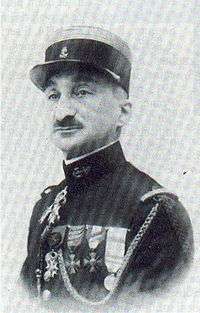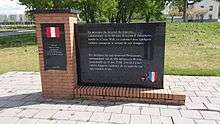Marcel Deslaurens
Marcel Émile Deslaurens (23 August 1883, in Bourges – 17 May 1940, in Vlissingen, Netherlands) was a French brigadier general. He died in World War II during an act of gallantry that allowed a number of his men to retreat safely.

Biography
Deslaurens graduated from the École spéciale militaire de Saint-Cyr in 1903 and began his career with the 24e régiment d'infanterie coloniale in 1903, then the 3e régiment de tirailleurs tonkinois in French Indochina. On his return to France in 1909 he went to Africa, first to the Ivory Coast and then to the governor's station in West Africa.
Deslaurens was at the Battle of the Somme with the 42e régiment d'infanterie coloniale, and was wounded twice. From 1922 to 1924 he was at the École supérieure de guerre, then he returned to Tonkin, French Indochina. From 1933 to 1935 he was a colonel in a regiment of colonial infantry in Morocco, and from 1936 to 1937 led the technical office of the colonial troops. From 1937 to 1939 he was back in Indochina.[1]
On 1 January 1940 he was given the command of the 60th Infantry Division of the Seventh Army (under Henri Giraud), headquartered at the castle of Esquelbecq, located in the north of France. In the waning days of the Battle of the Netherlands, as part of a maneuver toward Breda, his division entered Belgium and arrived at the mouth of the Scheldt on 10 May. After the Dutch capitulation, the division retreated into south Zeeland and found itself on the islands of Walcheren and South Beveland on 15 May. The next day fierce fighting took place on the Sloedam, which connects South Beveland and Walcheren, but the positions were overrun and Deslaurens and his men retreated to Walcheren[2] after an unsuccessful attempt to blow up the Sloedam.[3]
On Walcheren he also took command of men from the 68th Infantry Division. His main concern was to defend their position and prepare an organized escape back to France, and to raise the moral of the fatigued troops. On 17 May their positions were attacked by German artillery and airplanes, with Deslaurens inspecting his troops without regard for danger. Under severe pressure, the troops retreated to Vlissingen; orders were given to embark on French warships (under the command of admiral Charles Platon) that evening.[4] Amid the chaos of French troops that continued to pour in, and given the demoralized state of those troops, Deslaurens himself grabbed a rifle and covered the retreat, setting up a position with whatever soldiers and officers he could detain,[5] some four hundred meters from the embarkation. By 22:15 all had been evacuated except for Deslaurens and his small defensive group, who were all killed.[4][6][7][8]
He was one of thirteen French generals who died in May/June 1940.[9] Originally buried on the Noorderbegraafplaats in Vlissingen, his remains were later transferred to France.[10]
Ranks and awards

- 1905 sous-lieutenant
- 1907 lieutenant
- 25 December 1914 capitaine
- 18 October 1915 Chevalier de la Légion d'honneur
- 1923 chef de bataillon - officier de la Légion d'honneur
- 1928 lieutenant-colonel
- 1933 colonel
- 1937 général de brigade
- 1938 Commandeur de la Légion d'honneur
- 1940 Command of the 60e D.I.
A monument in his honor was erected in Vlissingen on 4 May 2001,[2] in the presence of his son and grandson.[11]
References
- "Deslaurens, Marcel-Emile, Brigadier-General (1883 – 1940)". Generals.dk. Archived from the original on 10 May 2011. Retrieved 28 April 2017.CS1 maint: BOT: original-url status unknown (link)
- Cats, Jacques (3 May 2001). "Franse generaal moest zijn moed met de dood bekopen". Provinciale Zeeuwse Courant (in Dutch). p. 13. Retrieved 28 April 2017.
- Lerecouvreux (1951). L'Armée Giraud en Hollande (1939-1940) (in French). Paris: Nouvelles Éditions Latines. p. 326.
- "Les officiers Généraux français morts au cours des opérations de mai-juin 1940". La Bataille de France (in French). Retrieved 27 April 2017.
- Lerecouvreux 327.
- "Strijd om de Sloedam, 17 mei en Franse steun". Zeeland 1940-1945 (in Dutch). Retrieved 27 April 2017.
- Amersfoort, Herman; Kamphuis, Piet, eds. (2005), Mei 1940 — De Strijd op Nederlands grondgebied (in Dutch), Den Haag: Sdu Uitgevers, p. 252, ISBN 90-12-08959-X
- Auphan, Paul; Mordai, Jacques (2016). The French Navy in World War II. Naval Institute Press. p. 57. ISBN 9781682470602.
- "Les officiers Généraux français morts au cours des opération". La Bataille de France (in French). Retrieved 28 April 2017.
- "Deslaurens, Marcel Emile; begraven op 18-05-1940". Registerkaarten Noorderbegraafplaats Tweede Wereldoorlog (in Dutch). Archived from the original on 30 May 2012. Retrieved 28 April 2017.CS1 maint: BOT: original-url status unknown (link)
- Van den Broek, Miriam (5 May 2001). "Eerbetoon aan gesneuvelde generaal". Provinciale Zeeuwse Courant (in Dutch). p. 11. Retrieved 28 April 2017.